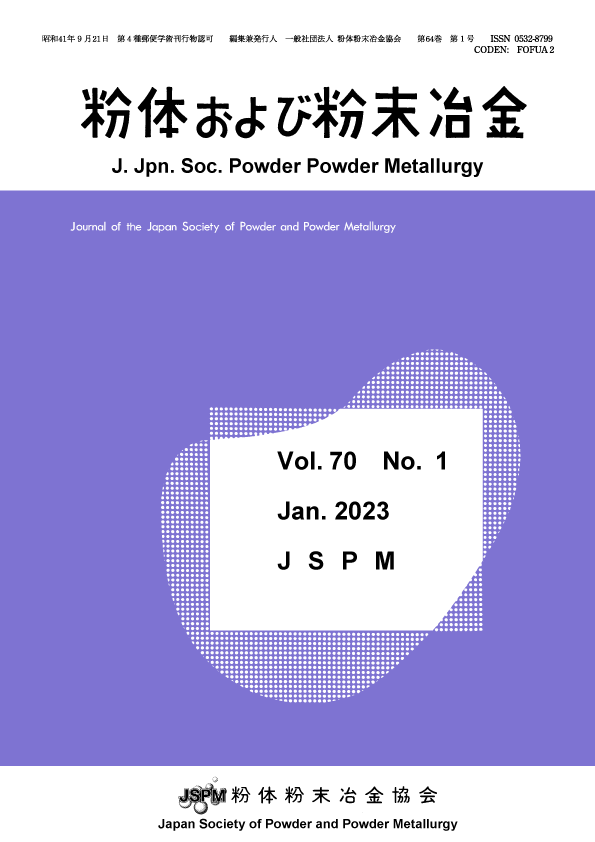
- |<
- <
- 1
- >
- >|
-
Yuichi SHIMAKAWA2023Volume 70Issue 11 Pages 445-450
Published: November 15, 2023
Released on J-STAGE: November 15, 2023
Advance online publication: September 05, 2023JOURNAL OPEN ACCESSTransition-metal oxides show lots of interesting and useful properties. The wide variety of their crystal structures gives rise to various electronic structures, which lead to various chemical and physical properties. The author has been interested in such transition-metal oxides and is seeking new materials with novel functional properties. In this review article new functional properties found in A-site-ordered quadruple perovskite structure oxides with the unusually high-valence cations are highlighted. Negative thermal expansion was found in NdCu3Fe4O12 at the intersite-charge-transfer transition temperature near room temperature. The property is useful for developing materials to compensate the normal positive thermal expansion. Significant latent heat was also found to be provided by the intersite-charge-transfer transition in NdCu3Fe4O12. The large latent heat is considered to be related with unusual first-order magnetic entropy change induced by the charge transition. The large entropy change can be utilized for thermal control through a caloric effect, which can make effective energy systems for thermal energy storage and refrigeration.
View full abstractDownload PDF (1249K)
-
Yasuyuki KANDA, Tomohide SHINJO2023Volume 70Issue 11 Pages 451-460
Published: November 15, 2023
Released on J-STAGE: November 15, 2023
Advance online publication: September 13, 2023JOURNAL OPEN ACCESSThis paper aims to fabricate a composite material using calcareous waste concrete powder and coal fly ash (FA) by spark plasma sintering. The effect of FA addition on the mechanical properties of the composite material were investigated. The maximum FA content was 7.5 wt%. The relative density of the composite material was approximately 1.0, independent of FA content. In contrast, the Vickers hardness, flexural strength, and flexural modulus increased with increasing FA content. However, the dispersion state of FA in the composite material was not observed by scanning electron microscopy. Powder X-ray diffraction of the composite material revealed that spurrite and wollastonite were formed identically, independent of FA content. Therefore, FA serves as a reinforcement in the composite material.
View full abstractDownload PDF (3677K) -
Kaoru KOUZU, Shigeru OKADA, Takeshi HAGIWARA, Akiko NOMURA, Toetsu SHI ...2023Volume 70Issue 11 Pages 461-465
Published: November 15, 2023
Released on J-STAGE: November 15, 2023
Advance online publication: September 28, 2023JOURNAL OPEN ACCESSCrystals of the new solid compounds Tm(Al1-xMnx)B4 (x = 0.002 ~ 0.100) and R(Al0.995Mn0.005)B4 (R = rare earth), were grown from R2O3 and crystalline B powders for Al and Mn mixed flux. Mixture of the starting materials was heated up to1773 K in an Ar atmosphere and kept at that temperature for 5 h, then the molten flux solution was slowly cooled down at a rate of 50 K/h. Tm(Al1-xMnx)B4 compounds were obtained as a single phase from the Al1-xMnx flux (x = 0.005 ~ 0.100). R(Al0.995Mn0.005)B4 compounds were obtained as in the case of R(Ho, Er, Tm, Yb, Lu). ThB4-type compounds were formed in the case of R (Gd, Tb, Dy, Ho). The lattice constants of Ho(Al, Mn)B4 and Lu(Al, Mn)B4 obtained were in the range of a = 3.475(1), b = 5.932(1), c = 11.465(1) Å and a = 3.434(1), b = 5.895(1), c = 11.391(1) Å. The lattice constants were smaller than those of RAlB4 by dissolving Mn atom into Al atom. The values of the hardness for R(Al, Mn)B4 were in the range of 11.9 ~ 13.7 GPa. The magnetic susceptibilities of both Er(Al0.995Mn0.005)B4 and Yb(Al0.995Mn0.005)B4 show antiferromagnetic transitions at 3.5 K and 12 K, respectively.
View full abstractDownload PDF (1113K)
-
Solid - State Recycled Materials Fabricated from Mg Cutting Chips by MM-SPS Process and Its PropertyTakumi TANAKA, Masahiro KUBOTA2023Volume 70Issue 11 Pages 466-471
Published: November 15, 2023
Released on J-STAGE: November 15, 2023
JOURNAL OPEN ACCESSThe purpose of this research is to produce high hardness of Mg from cutting chips using MM-SPS process. Effects of different starting materials, such as powder and cutting chips of Mg, on the properties were investigated. The influence of sintering holding times on the properties was also investigated to establish between the process conditions and the properties. Hardness testing and X-ray diffraction were carried out for characterization of powders and bulk materials. The results of hardness indicated that MM-SPS process can synthesis upgrade recycled material fabricated from Mg cutting chips. In the case of cutting chips, the maximum hardness was observed at 6 hours of MM and 60 min of sintering holding time. On the other hand, in the case of powder showed the maximum hardness at 6 hours of MM and 10 min of sintering holding time. However, the hardness did not increase with increasing sintering holding time. No solid-state reaction was observed in SPS materials fabricated from powder and cutting chips. In addition, no contamination of impurities during MM treatment was observed.
View full abstractDownload PDF (1350K)
-
2023Volume 70Issue 11 Pages Pref11_1
Published: November 15, 2023
Released on J-STAGE: November 15, 2023
JOURNAL OPEN ACCESSDownload PDF (891K) -
2023Volume 70Issue 11 Pages Pref11_2
Published: November 15, 2023
Released on J-STAGE: November 15, 2023
JOURNAL OPEN ACCESSDownload PDF (131K)
- |<
- <
- 1
- >
- >|